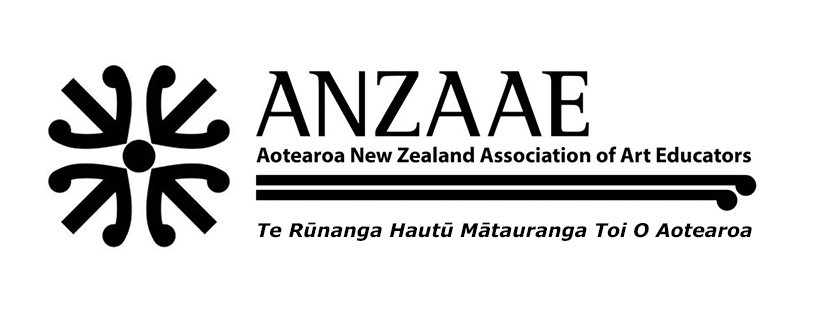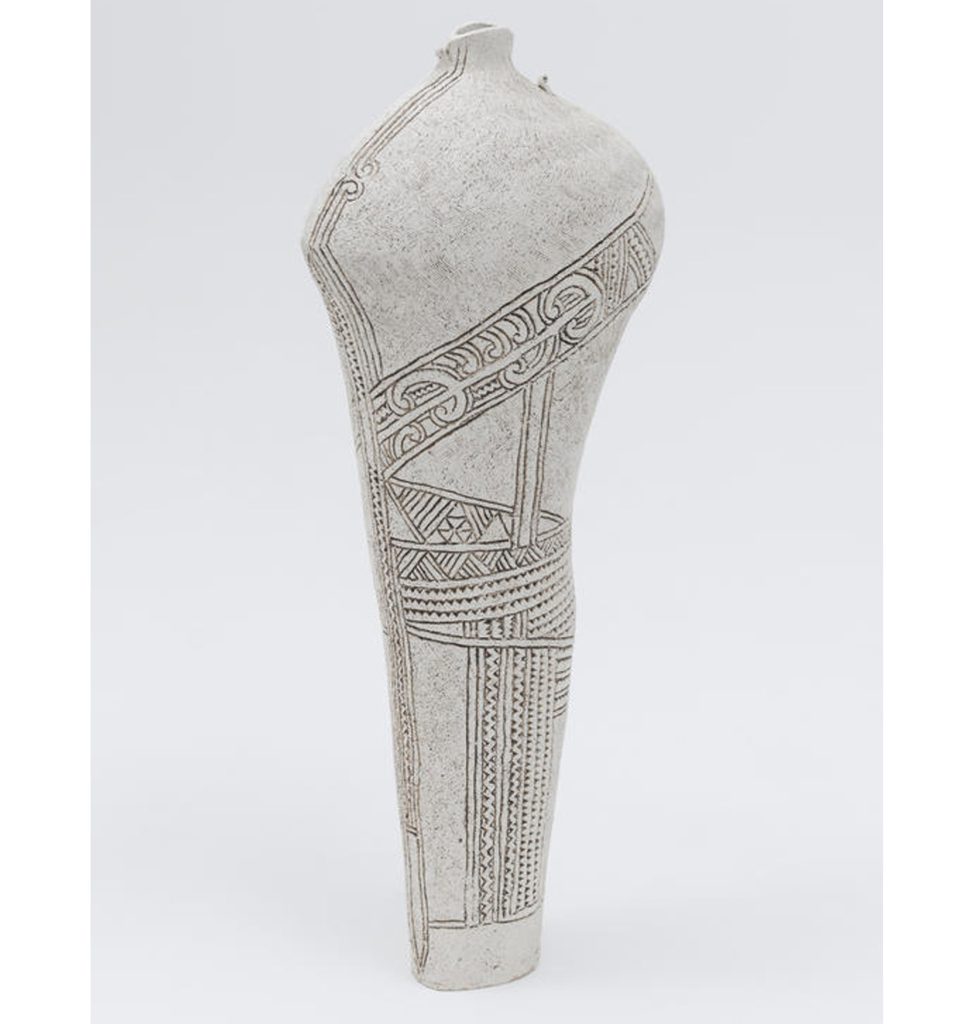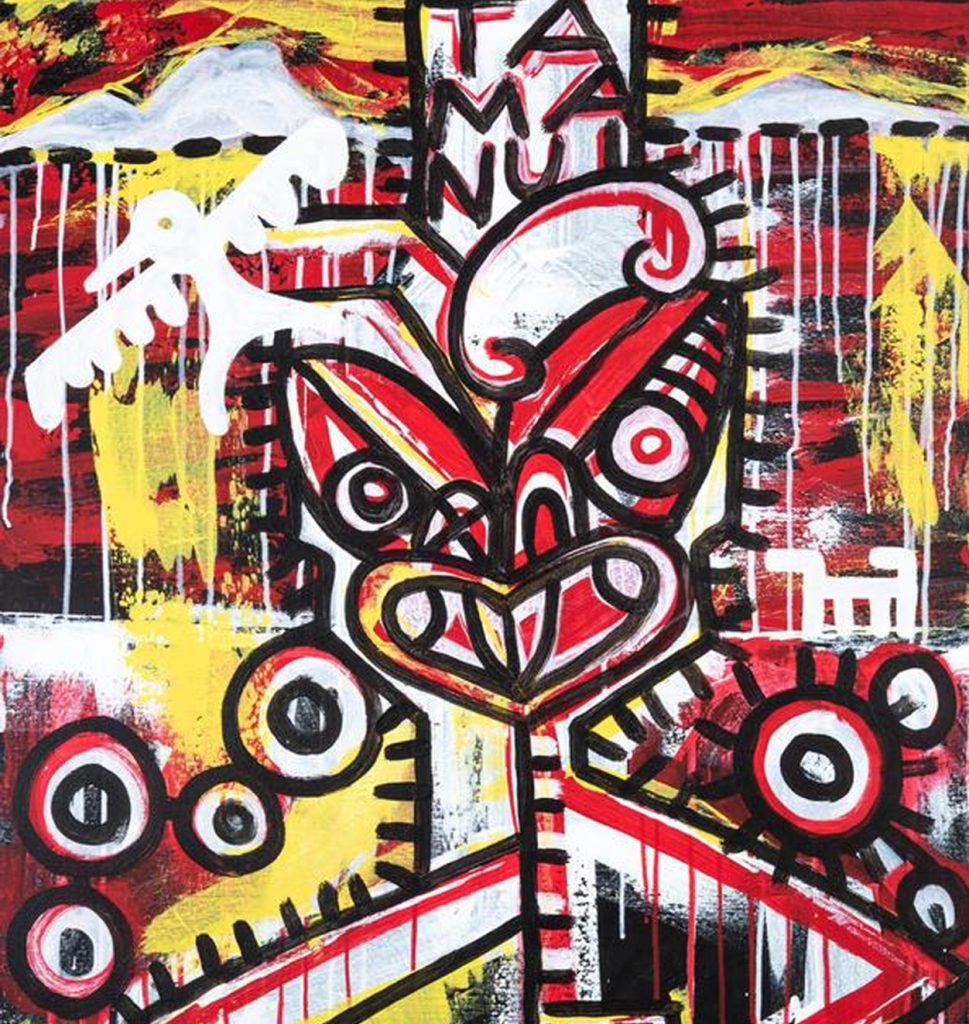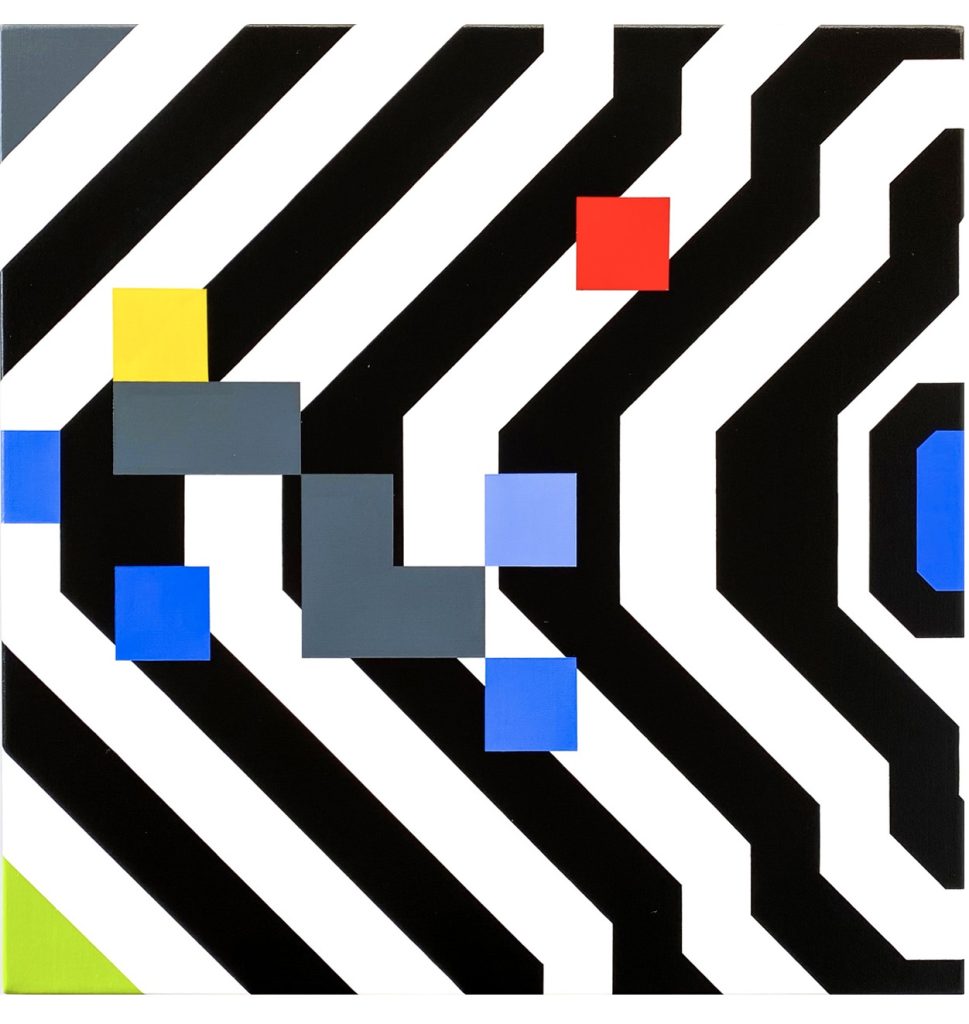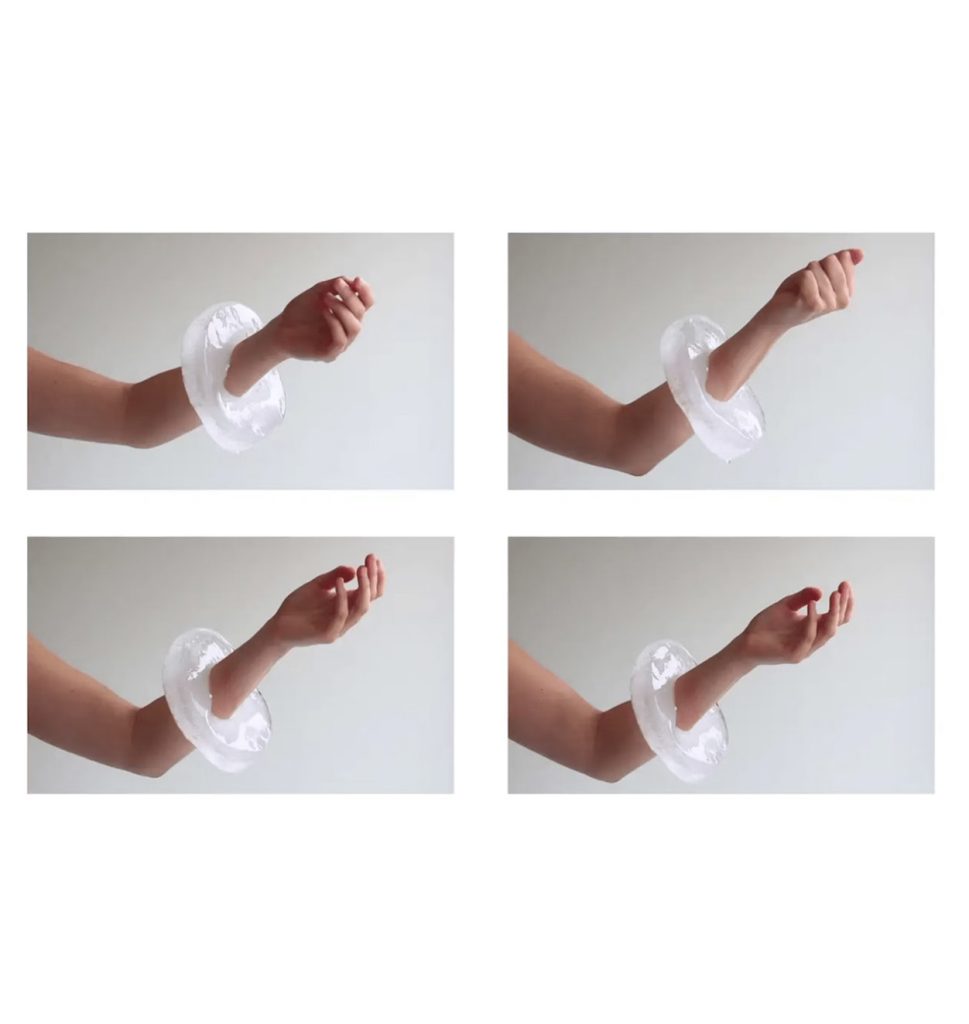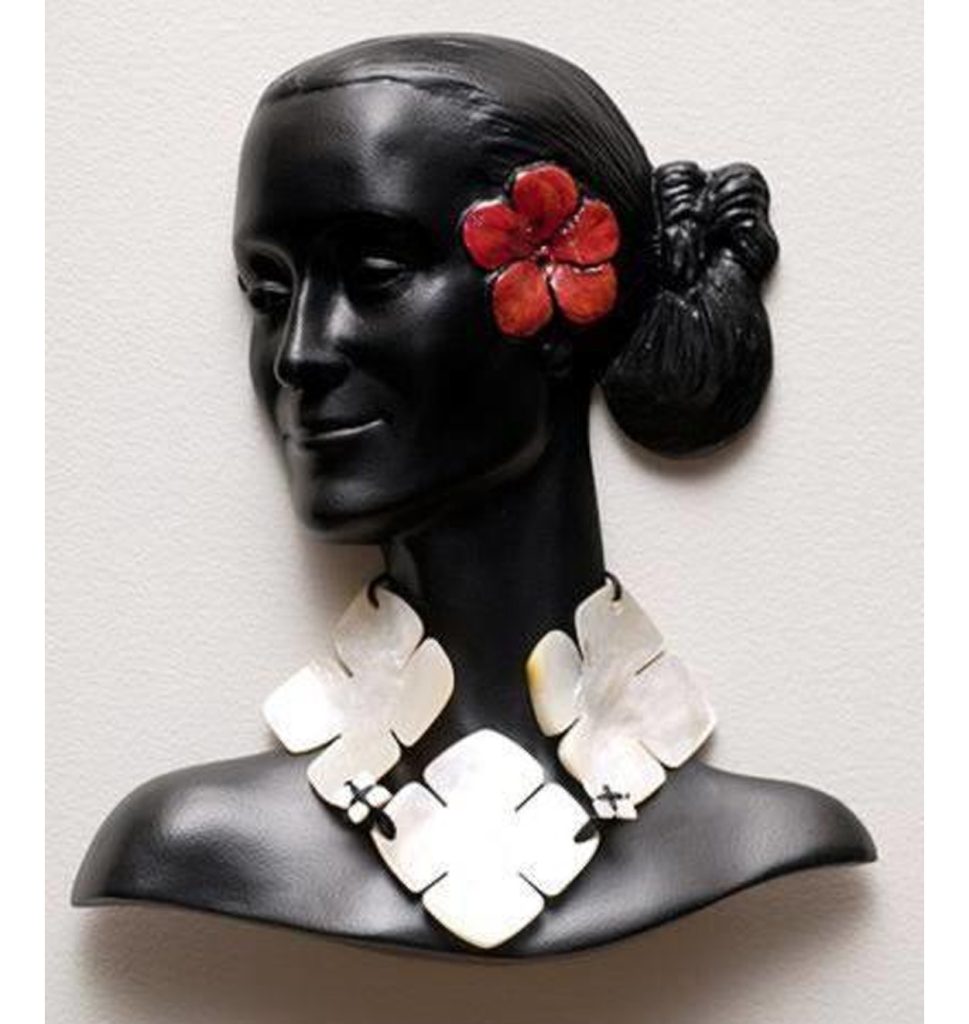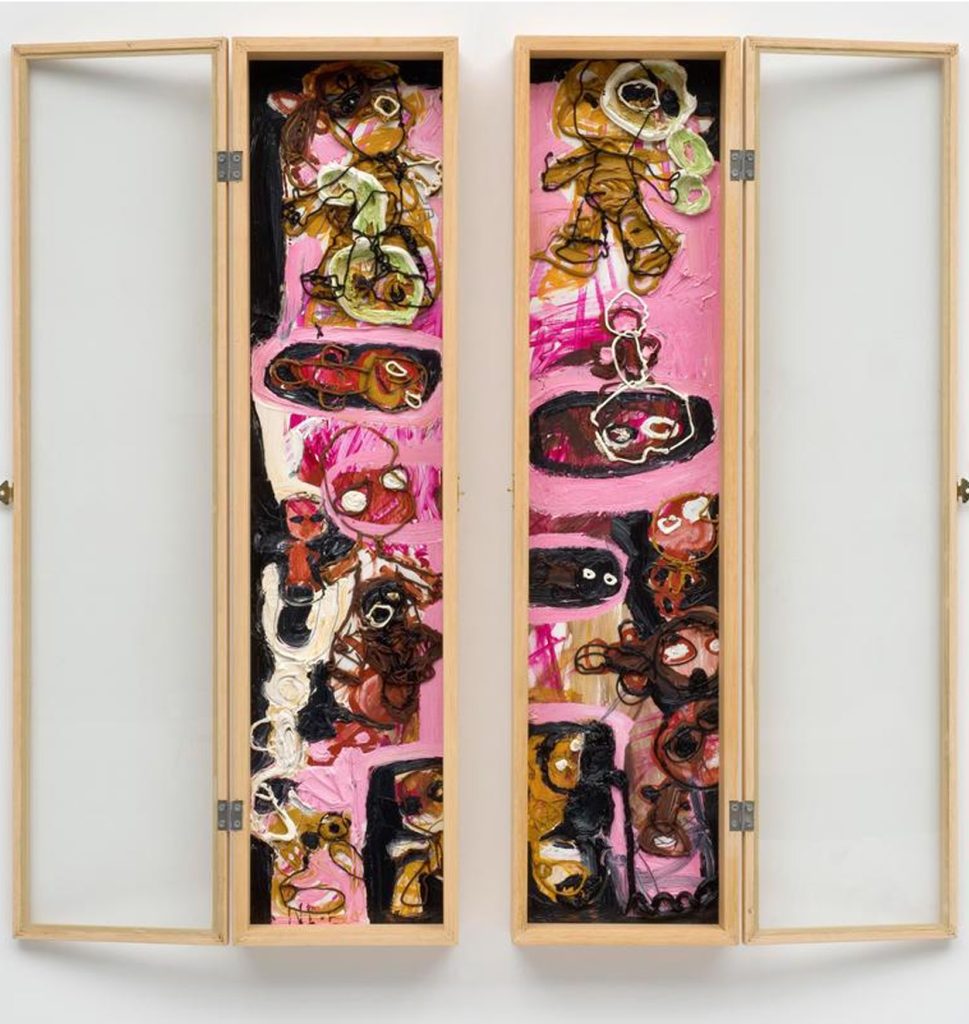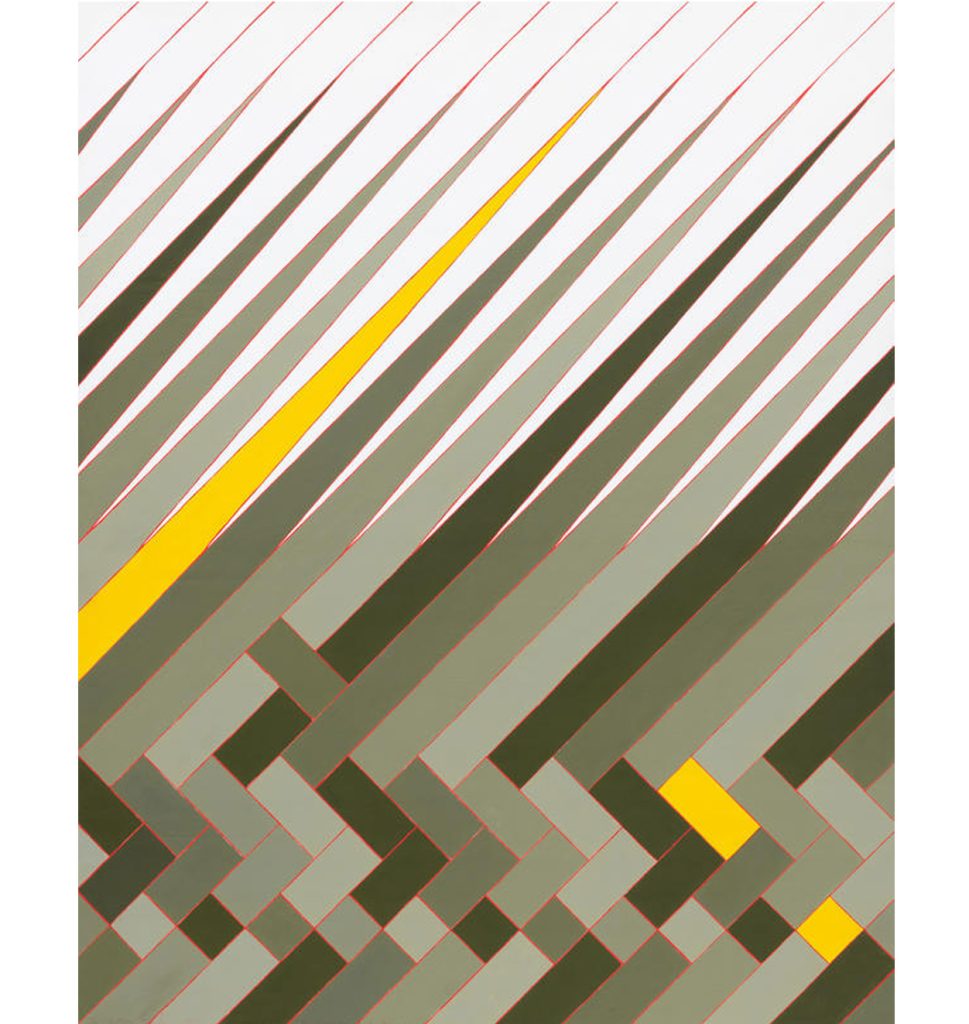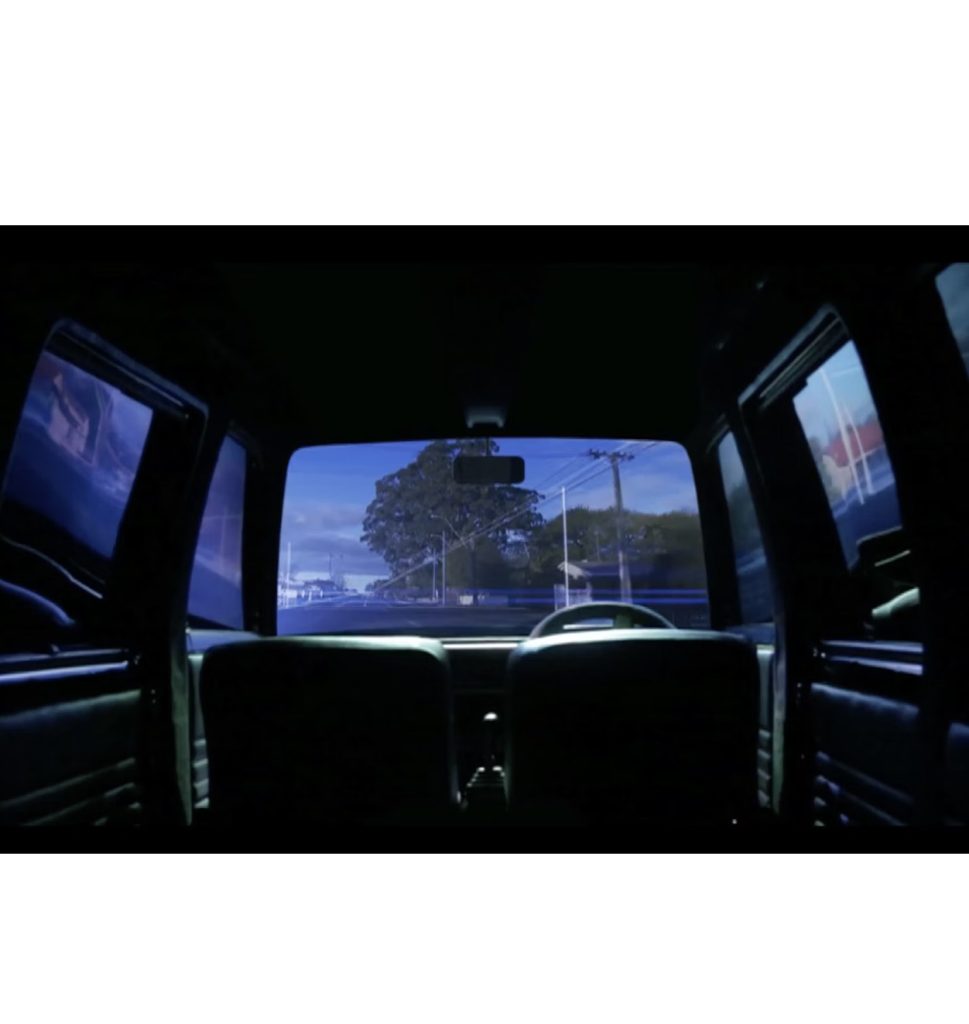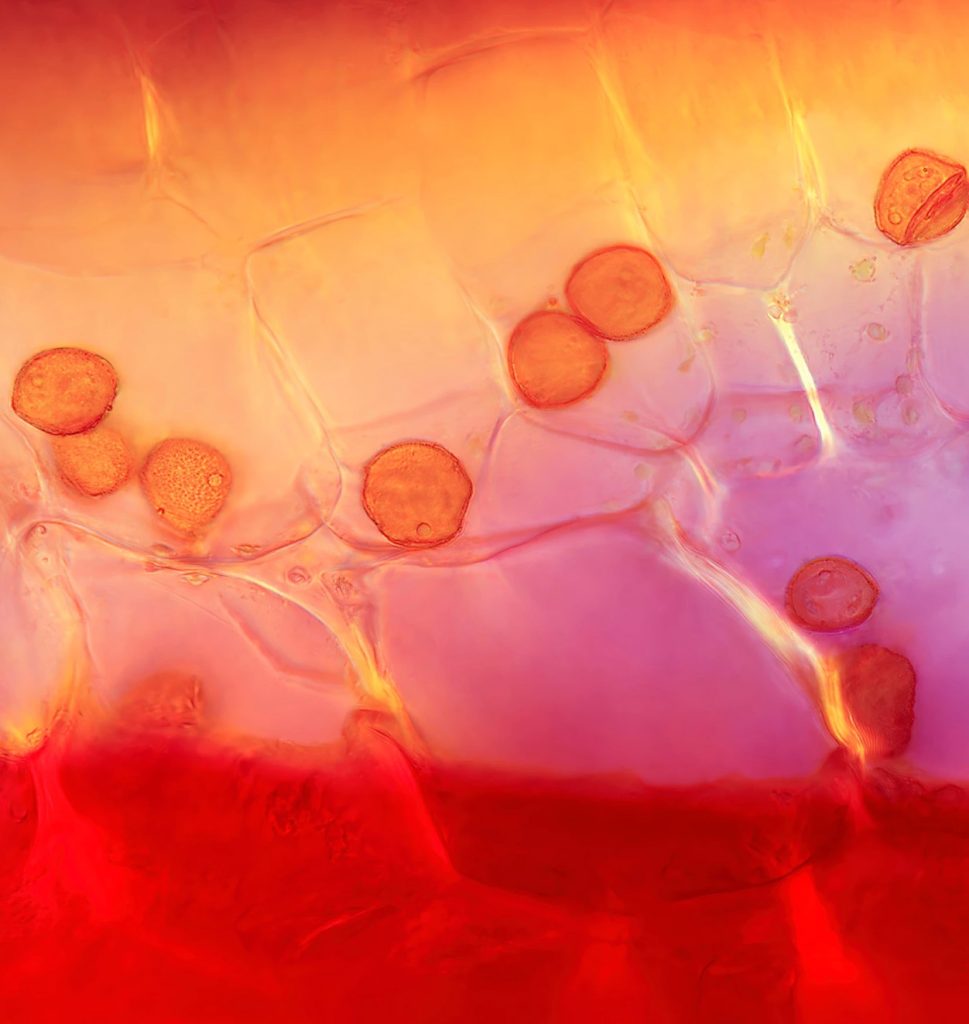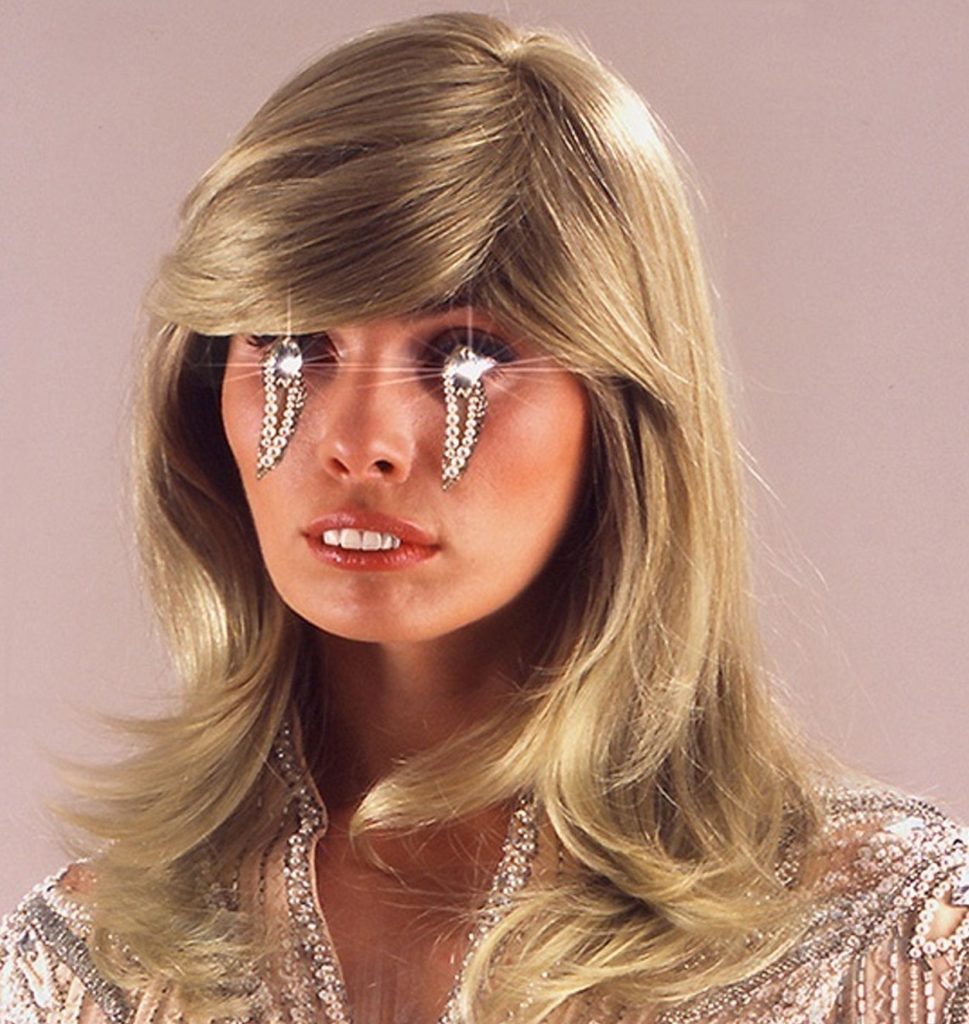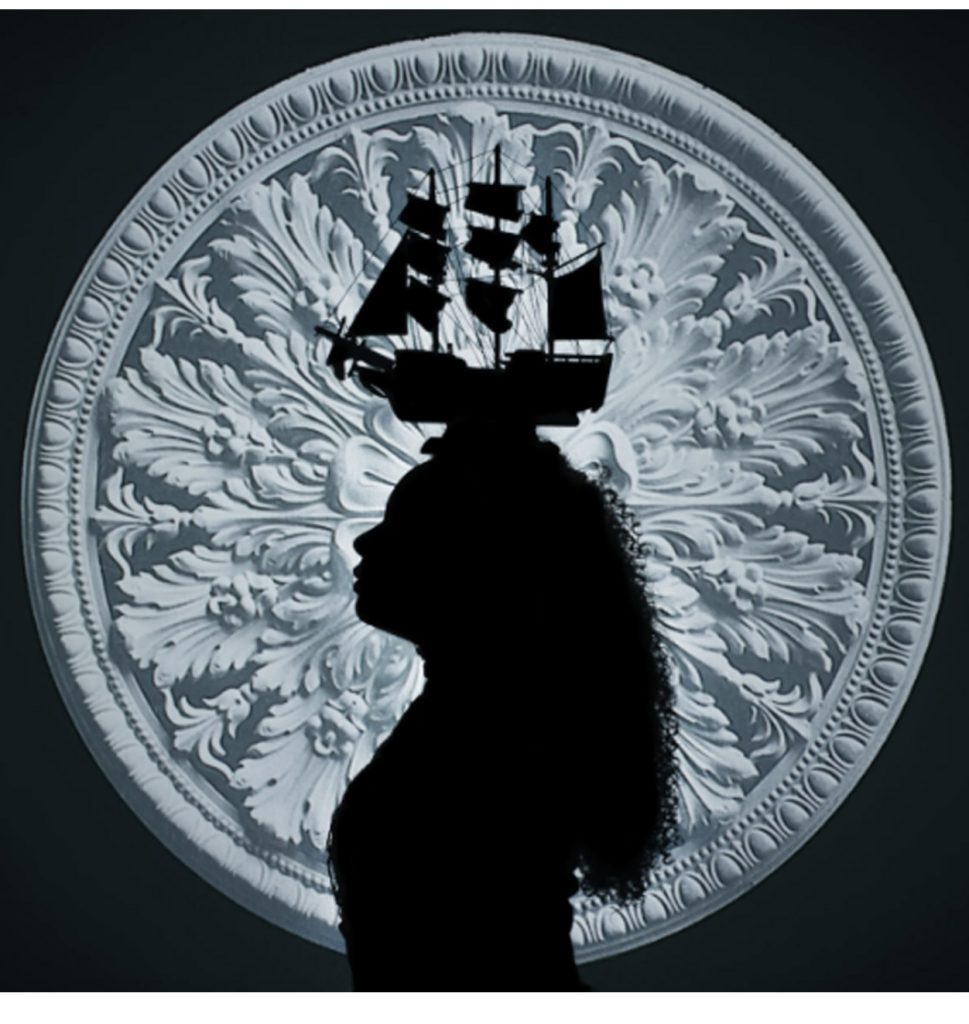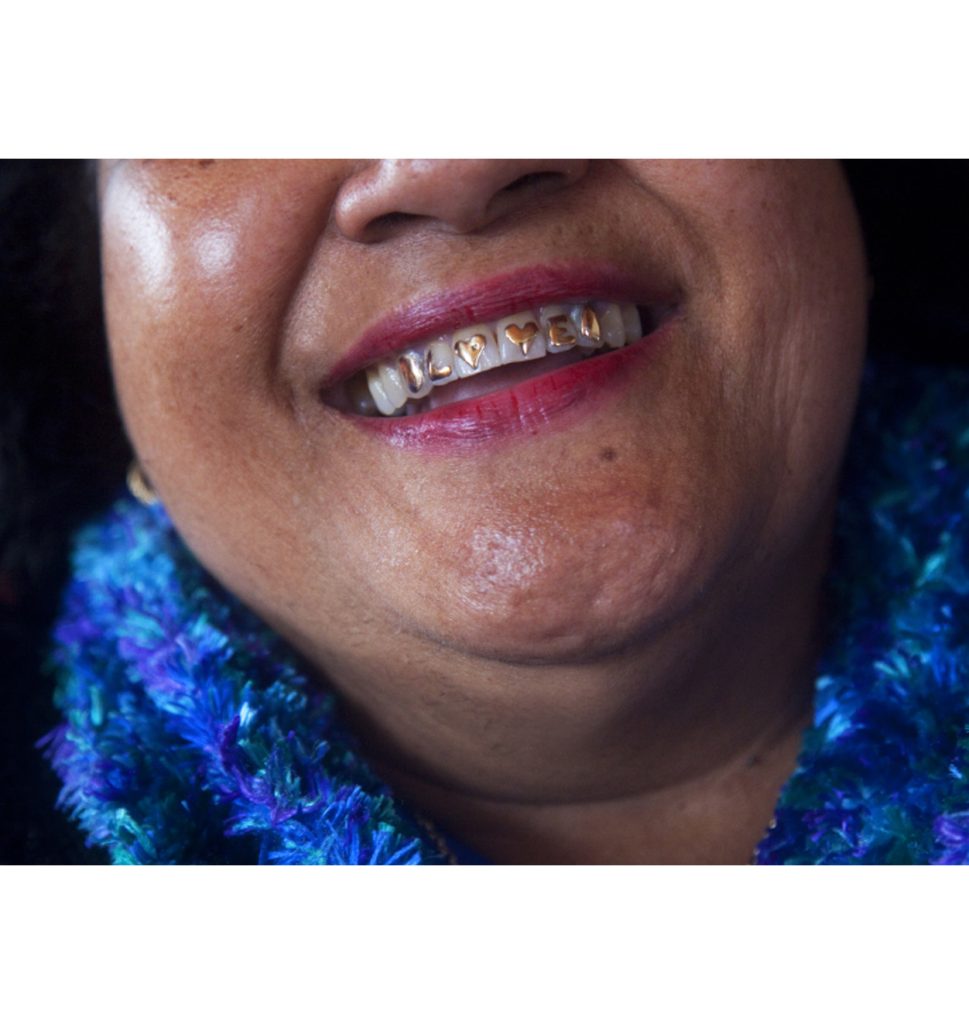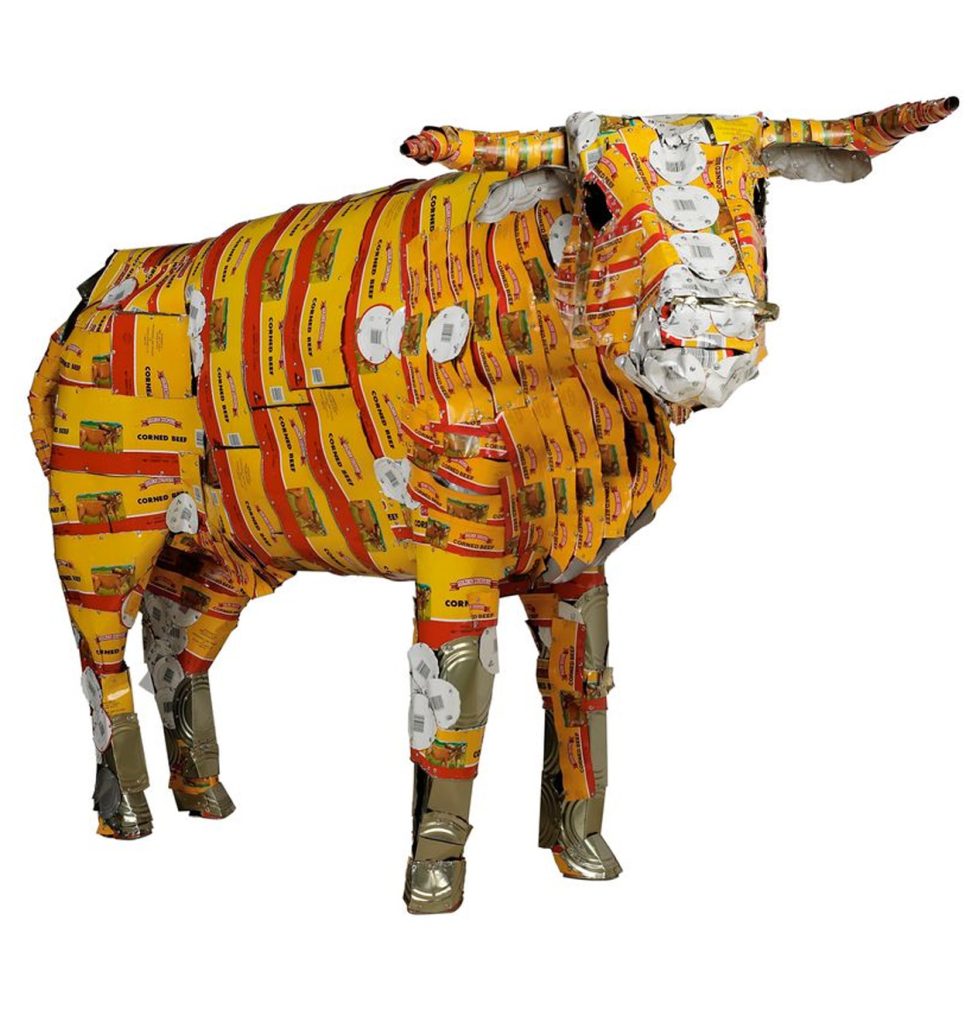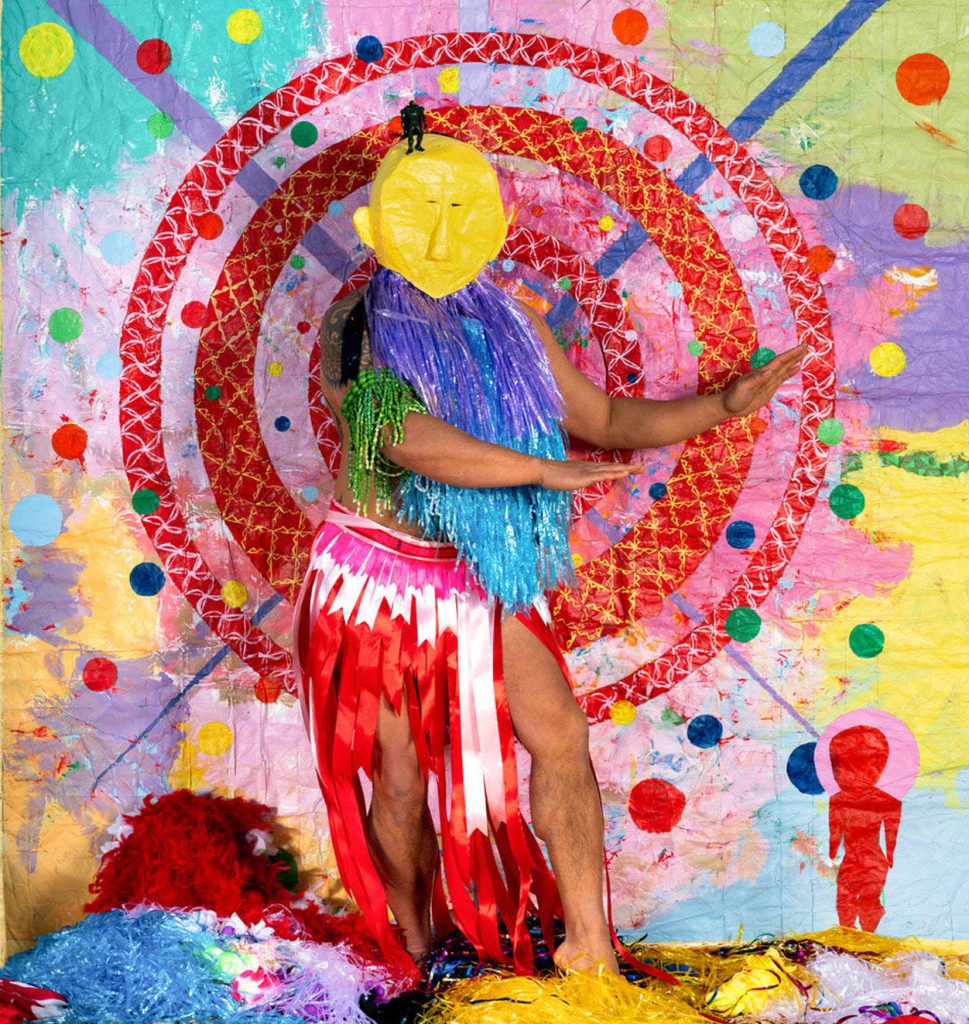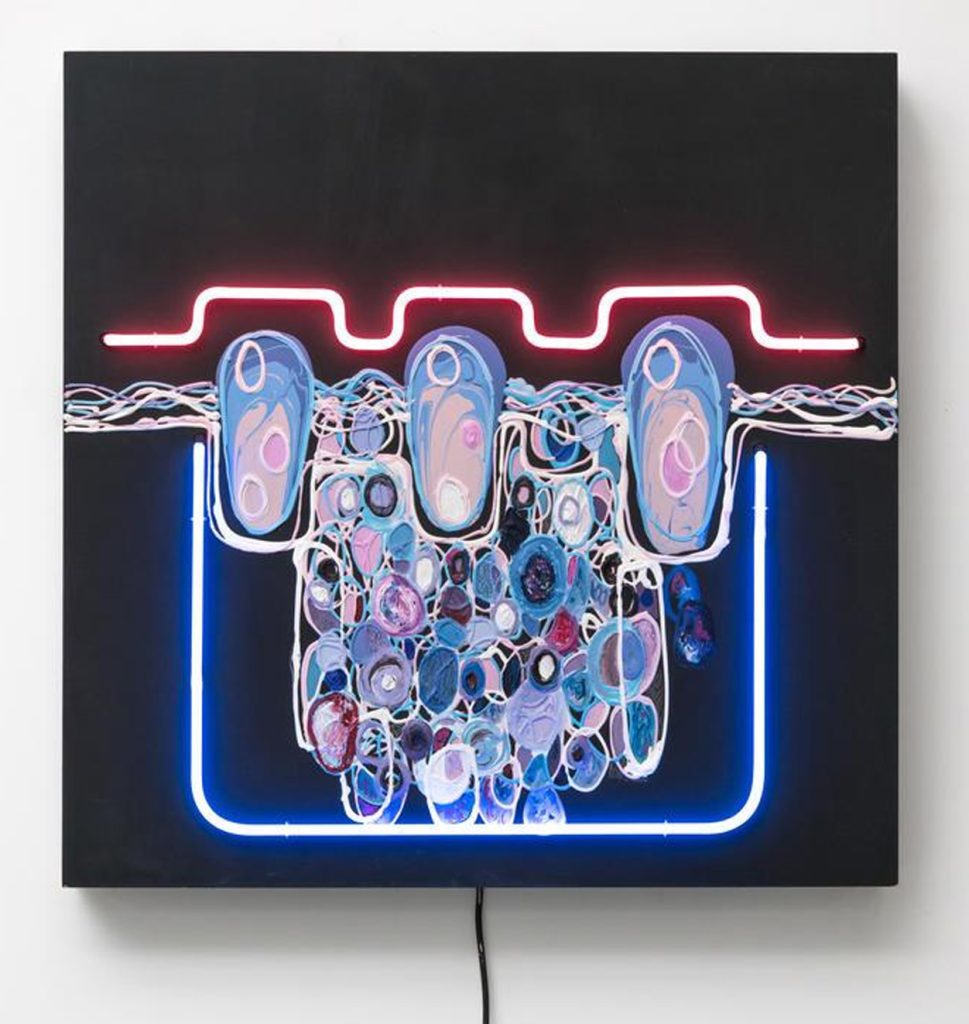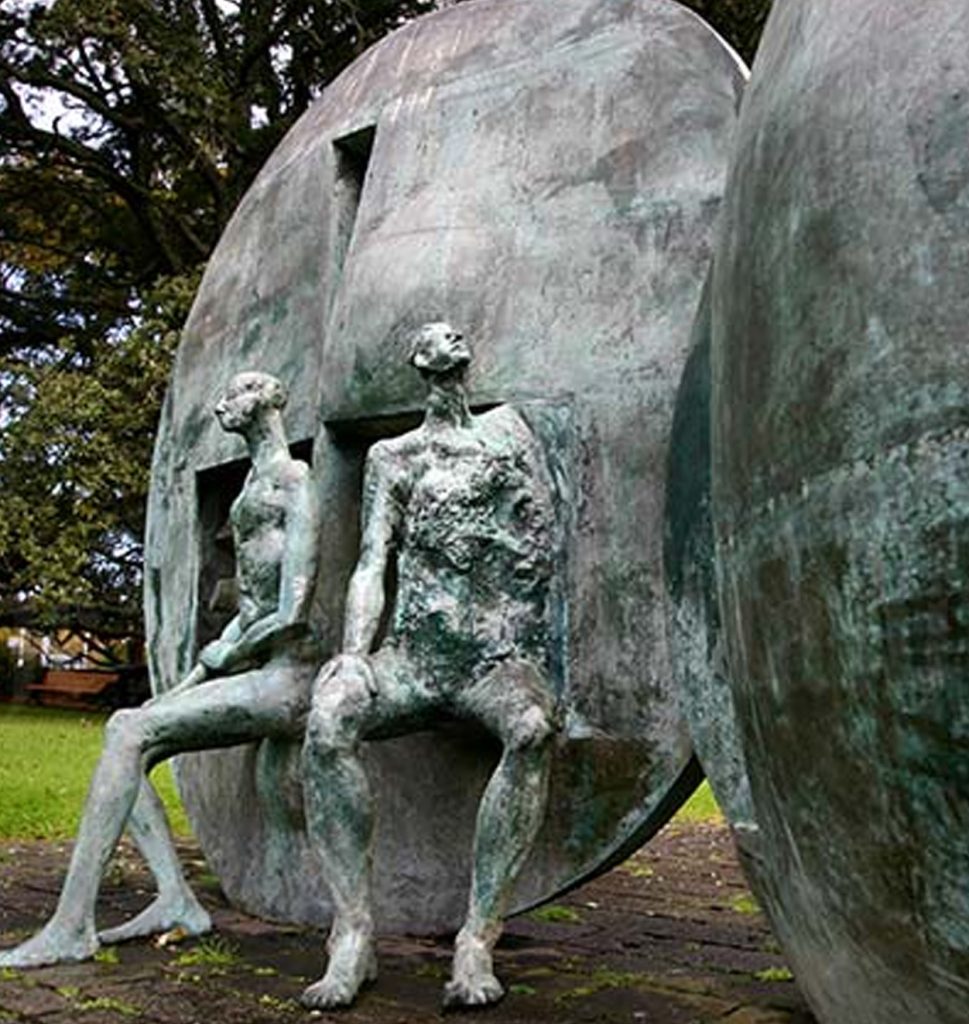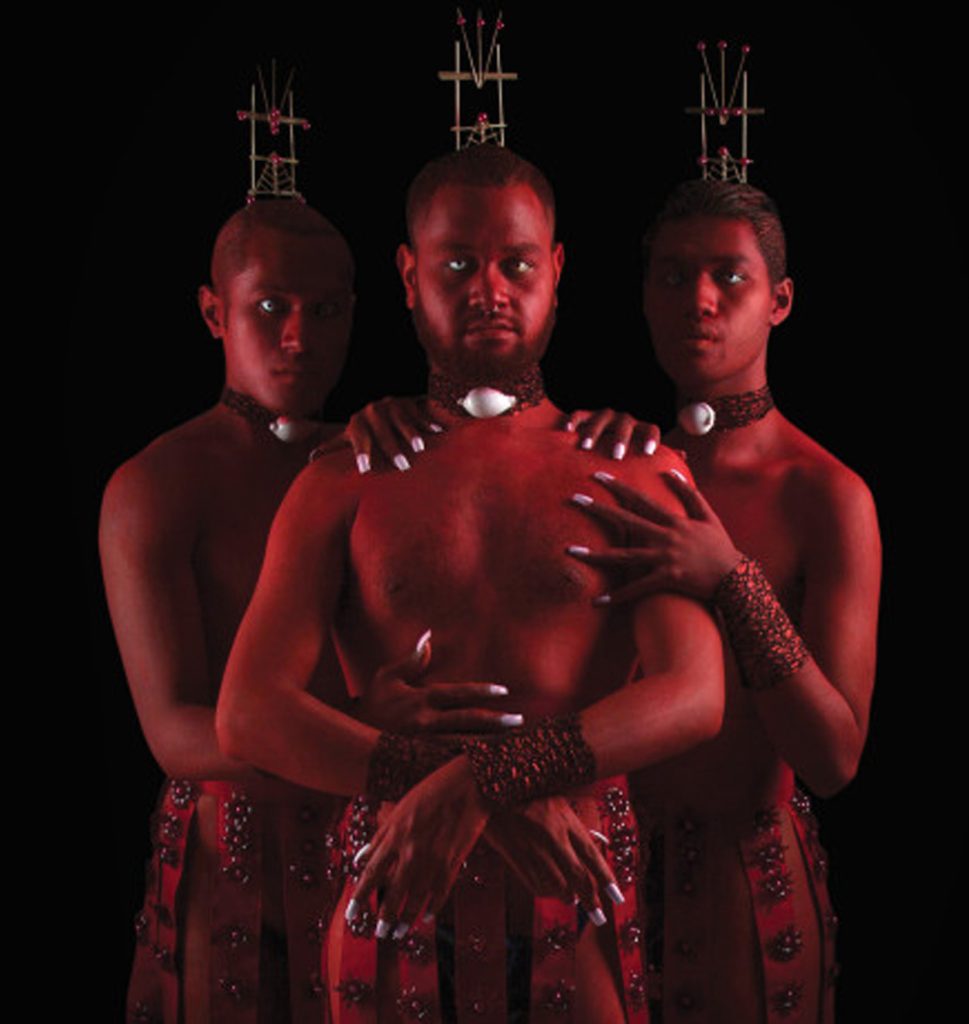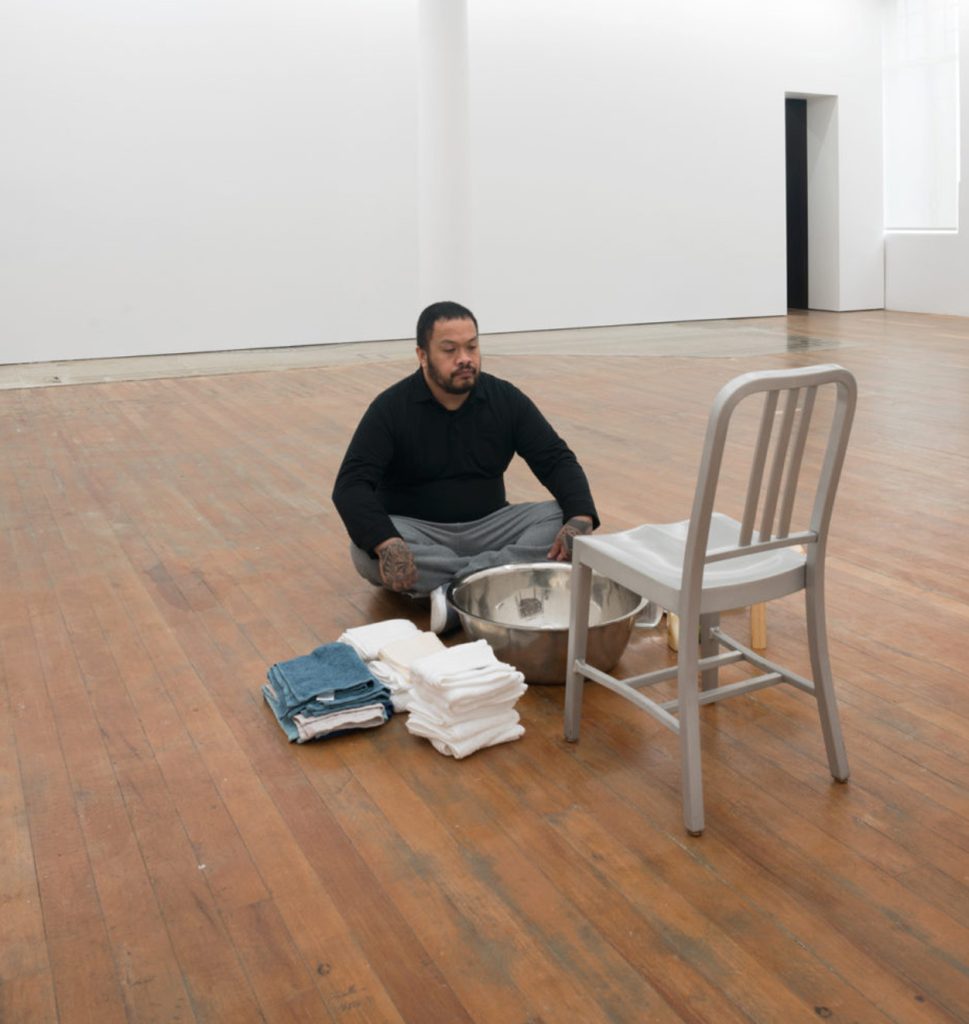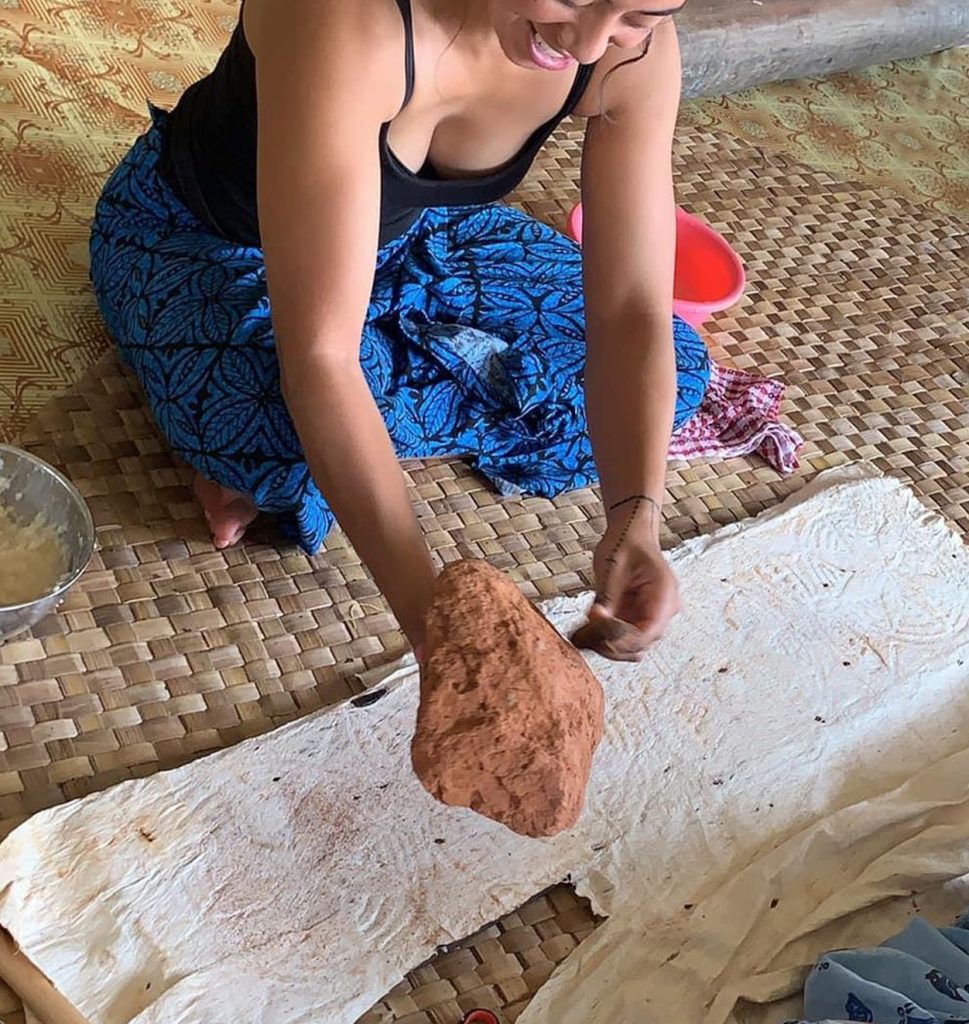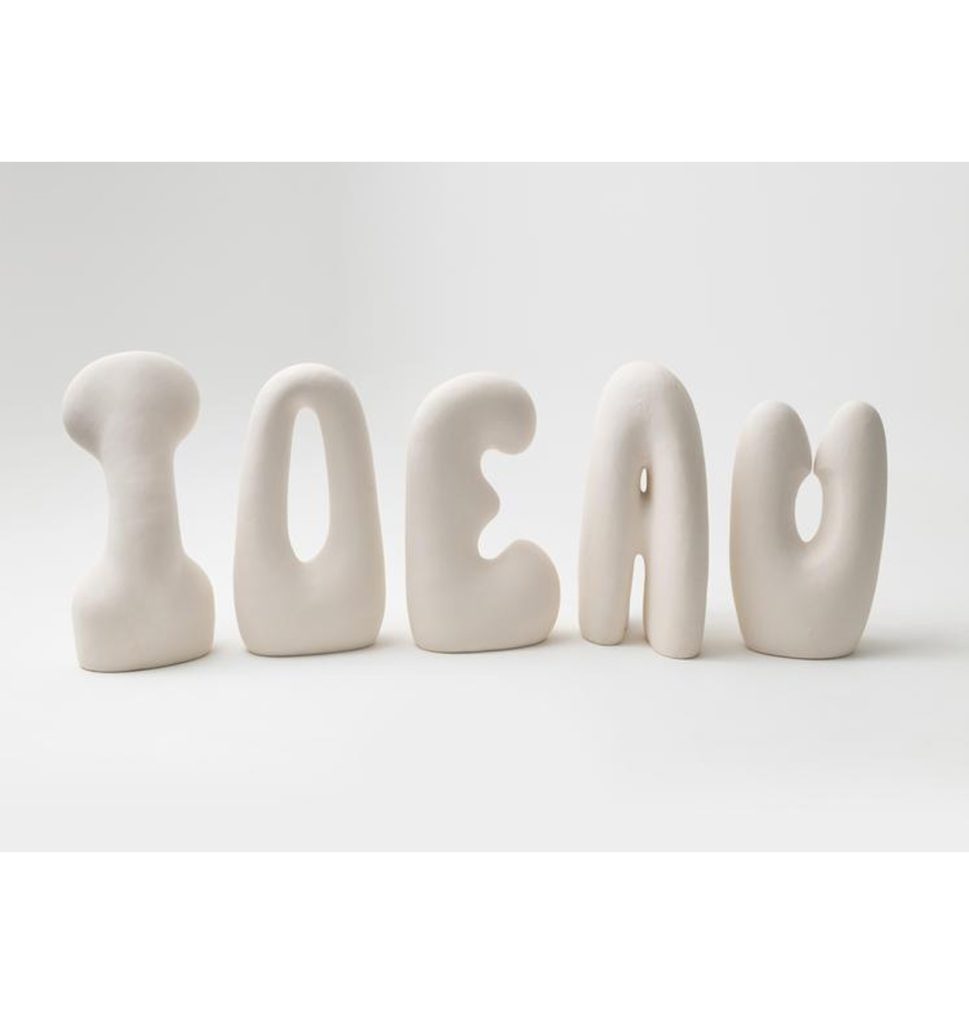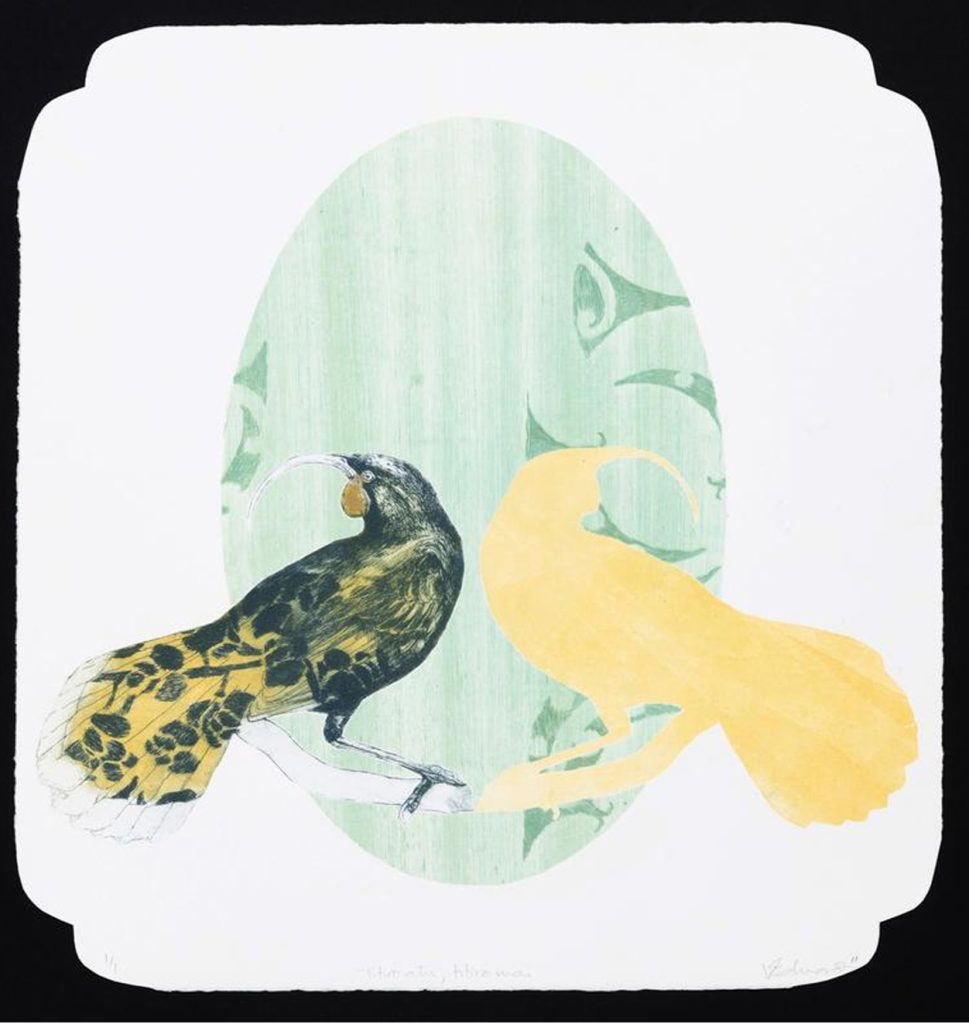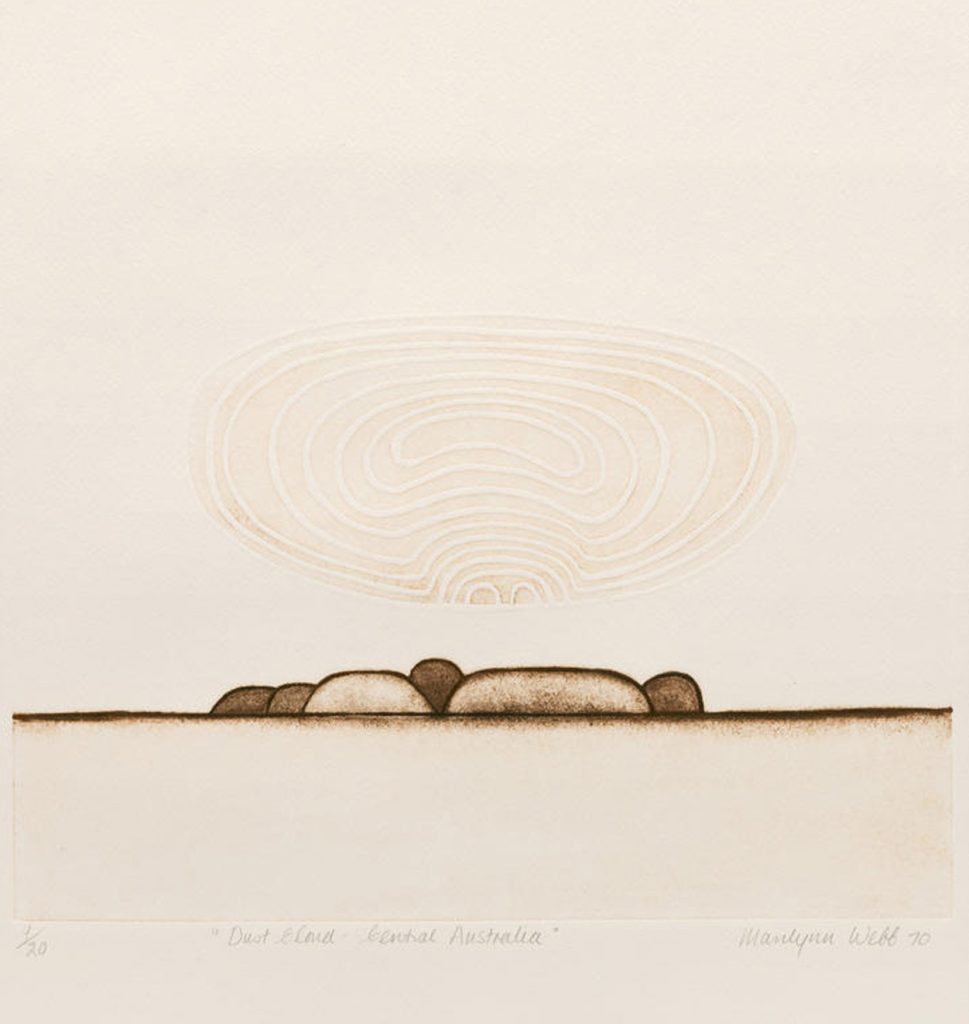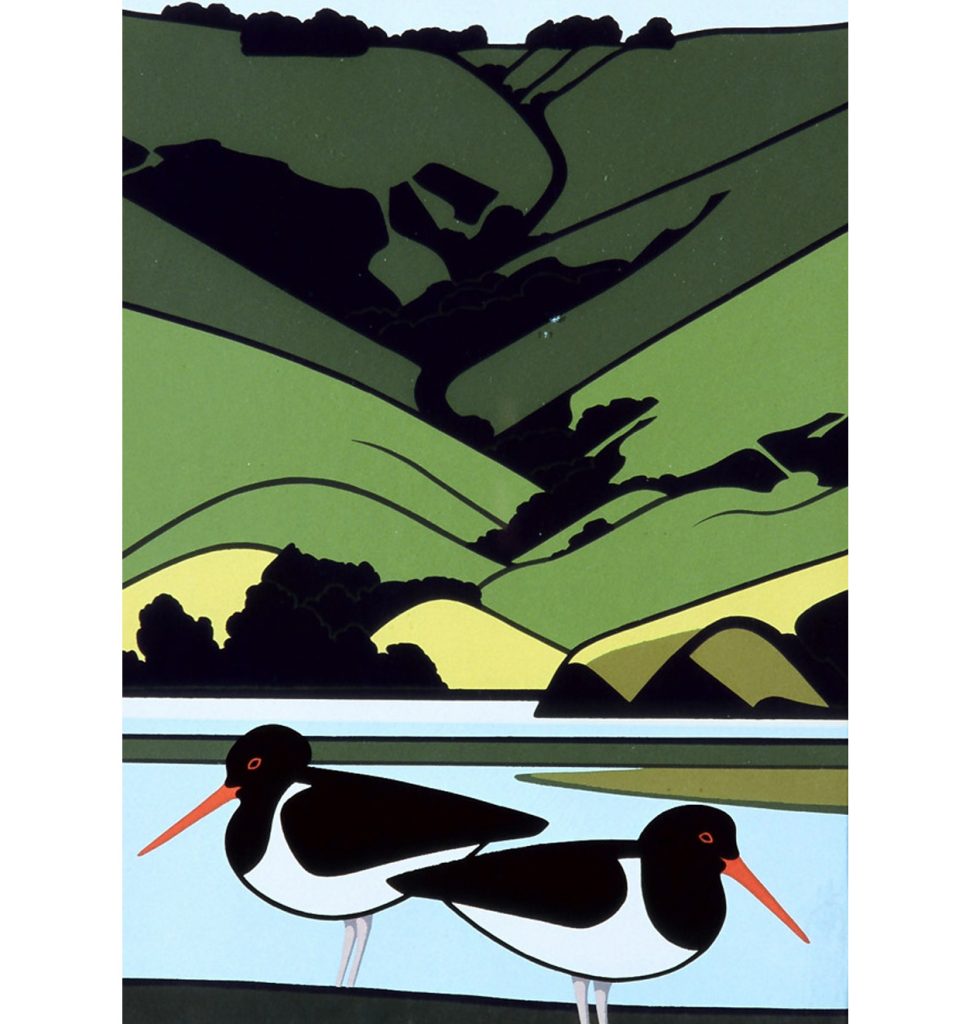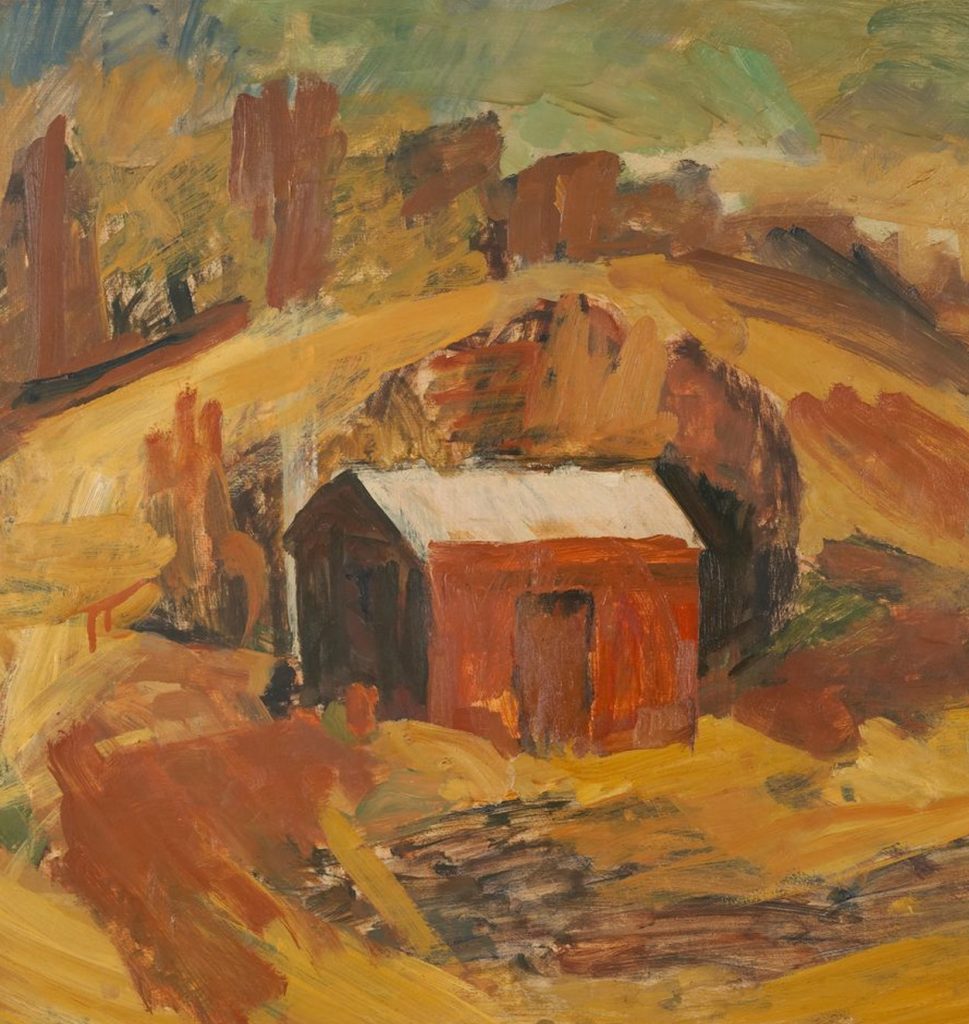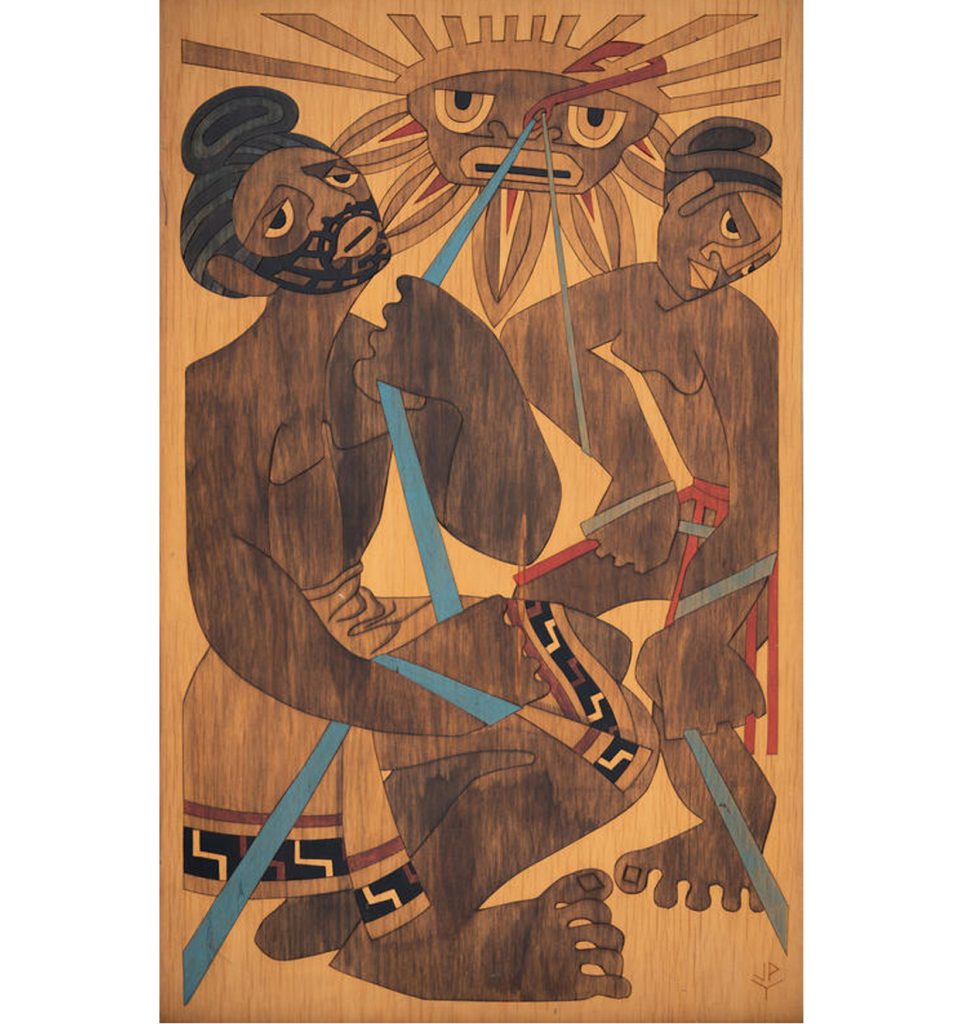Aotearoa Artists T – Z
KEREAMA TAEPA (B. 1972)
Iwi: Te Arawa, Te Āti Awa
Auckland Art Gallery, Toi o Tāmaki
Jhana Millers Gallery
Kereama Taepa is a multidisciplinary visual artist based in Tauranga Moana who works across fashion, painting, sculpture, and digital technologies. Taepa’s artistic practice reflects a deep exploration of the dynamic nature of Māori culture, drawing inspiration from its rich heritage while pushing boundaries and embracing innovation. By engaging with different artistic media, Taepa contributes to the ongoing dialogue surrounding the innovative practices and contemporary expressions within te ao Māori. His multidisciplinary approach allows him to explore and challenge artistic conventions while maintaining a strong connection to the Māori artistic legacy.
NGATAIHARURU TAEPa (B. 1976)
Iwi: Ngāti Whakaue (Te Arawa), Te Āti Awa
Auckland Art Gallery
Page Galleries
Ngataiharuru Taepa current artistic practice encompasses installation works that explore contemporary issues within New Zealand society. Additionally, he creates paintings and woodworks, drawing inspiration from his enduring fascination with kōwhaiwhai, a traditional Māori art form.
Kōwhaiwhai, also known as tuhituhi, can be considered the Māori equivalent of writing. It served as the means through which Māori ancestors conveyed their observations of the world through a visual language. Taepa recognises the historical significance of kōwhaiwhai predating the written word in Māori culture. His master’s study involved examining the impact of written language on Māori visual culture and gaining a deeper understanding of kōwhaiwhai as a visual language.
WI TAEPA (B. 1946)
Iwi: Ngāti Pikiao, Te-Roro-o-Te-Rangi, Te Arawa and Te Atiawa
Auckland Art Gallery, Toi o Tāmaki
Museum of New Zealand, Te Papa Tongarewa
Wi Taepa is a visual artist from Aotearoa that employs hand-building techniques rather than a potter’s wheel to shape clay into vessels and sculptures. He utilises methods such as coil, pinch, and slab to create diverse forms, textures, and surface patterns in his artwork. Initially, Taepa draws inspiration from traditional Māori designs to adorn his vessels, allowing him to express his cultural heritage. As his artistic journey progressed, he continued to incorporate elements from his cultural tradition, but also reimagined kōwhaiwhai (rafter patterns), tukutuku (woven panels), and weaving patterns to align with his evolving ideas and philosophy.
TĀWERA TAHURI (B. 1970)
Iwi: Ngā Ariki Kaipūtahi, Te Whakatōhea, Ngāti Uenuku, Ngāti Tūwharetoa
Auckland Art Gallery, Toi o Tāmaki
Te Atinga, Contemporary Visual Arts
Tāwera Tahuri is a mixed media artist who explores a range of mediums and techniques in her artwork. She draws inspiration from various artists, including Basquiat, Klee, Picasso, Kura Te Waru Rewiri, and Emere Karaka. Their influences can be seen in the breadth and depth of Tahuri’s creative output, as she has produced a significant body of work throughout her artistic career.
Beyond her artistic pursuits, Tahuri also plays important roles in her community. She is a mother of six children and a grandmother of four, emphasising the significance of family and community in her life. In addition to her artistic practice, Tahuri actively engages in activism, teaching, and performance. Her involvement in these areas highlights her commitment to making a positive impact within her community and using art as a means of expression and change.
KELCY TARATOA (B. 1972)
Iwi: Ngāi Te Rangi, Ngāti Ranginui, Ngāti Raukawa
Auckland Art Gallery, Toi o Tāmaki
Artist Website
Melanie Roger
Kelcy Taratoa is an artist whose practice encompasses various elements such as comic-book superhero characters, overexposed graphics depicting urban environments, vibrant colors, and meticulous finishes. Through his art, Taratoa addresses themes of alienation and ethnic disparity, examining the contrast between the physical, tangible aspects of life and the virtual or alternative realities that exist. His work delves into highly political and deeply personal subjects, exploring issues of privacy, environmental threats, popular culture, and technology.
Taratoa’s artworks are characterised by their engagement with contemporary concerns and their visually striking aesthetic. By combining elements from different realms, he creates thought-provoking pieces that prompt reflection on the complexities of the world we inhabit.
SHANNON TE AO (B. 1978)
Iwi: Ngāti Tūwharetoa, Australian
Auckland Art Gallery, Toi o Tāmaki
College of Creative Arts, Toi Rauwharangi
Shannon Te Ao is a multidisciplinary artist who examines and experiments with alternative creative, social, and linguistic models, particularly within the realm of contemporary video art and other forms of performance. Te Ao navigates the boundaries between melancholy and optimism in his work. He explores the complexities of language and interpersonal relationships by drawing upon oral traditions such as karakia (incantations), waiata (songs), and whakatauki (proverbs), as well as incorporating elements from song lyrics, performative gestures, and cinematic techniques.
JASMINE TE HIRA (B. 1990)
Iwi: Te Rarawa, Ngāpuhi, Atiu/Cook Islands, Devonshire/England
Auckland Art Gallery, Toi o Tāmaki
CIRCUIT
Jasmine Te Hira artistic practice is centered around installation-based and experiential art. She employs a variety of mediums such as objects, videos, atmospheres, and constructed spaces to create her works. Te Hira is interested in how individuals engage with and interpret their surroundings, communities, and larger social structures. Her focus lies in examining how personal perspectives intersect and interact within these contexts.
In her artistic practice, Te Hira weaves together concepts related to time, memory, and perception. She expresses these ideas through various mediums, including jewelry, video art, and ephemeral creations. Through her work, she seeks to articulate and provoke contemplation on these fundamental aspects of human experience.
Sofia Tekela-Smith (b. 1970)
Scottish, Rotuman
Bartley and Company
Auckland Art Gallery
Sofia Tekela-Smith is a New Zealand artist who works with jewelry and body adornment of Scottish and Rotuman descent. Her practice reflects and communicates her Polynesian worldview through the use of jewellery and other art objects.
SAFFRONN TE RATANA (B. 1975)
Iwi: Ngāi Tūhoe
Auckland Art Gallery, Toi o Tāmaki
Saffronn Te Ratana’s paintings employ mark-making and three-dimensional structures to extend and deconstruct the conventions of painting, playing with notions of space and narrative. Te Ratana practice explores Māori histories, identities and experiences, including collaborations with her partner Ngataiharuru Taepa and artist Hemi Macgregor.
TOI TE RITO MAIHI (B. 1937)
Iwi: Ngāpuhi, Ngāti Kahu, Ngāti Rangi, Ngāti Kauwhata
Auckland Art Gallery, Toi o Tāmaki
Toi Ngāpuhi
Toi Te Rito Maihi, born in Heretaunga/Hastings in 1937, has dedicated three decades to her artistic practice as a painter, printmaker, and weaver. Maihi played a foundational role as a member of Aotearoa Moananui-a-Kiwa Weavers, which later became known as Te Roopu Raranga Whatu o Aotearoa. She also contributed to the Māori and South Pacific Arts Council, served on the Crafts Panel of the Arts Council of New Zealand, and held a position on the Executive Committee of Ngā Puna Waihanga.
TERRI TE TAU
Iwi: Rangitāne ki Wairarapa, Ngāti Kahungunu
Terri Te Tau is an artist and writer who is actively engaged in researching the convergence of historical Māori narratives, science, and speculative fiction. Additionally, Terri is a member of Mata Aho, a collective consisting of four Māori women who collaborate on extensive textile-based projects. One of their notable works, titled ‘Kiko Moana,’ was exhibited at documenta 14 in Germany in 2017 and later showcased at the Royal Academy in London as part of the ‘Oceania’ exhibition in 2018. Another significant achievement for Mata Aho was their work ‘Kaokao’ being selected as a finalist in the APB Foundation Signature Art Prize held in Singapore in 2018.
KURA TE WARU REWIRI (B. 1950)
Iwi: Ngāpuhi, Ngāti Kahu, Ngāti Rangi, Ngāti Kauwhata
Auckland Art Gallery, Toi o Tāmaki
Toi Rauwhārangi, Massey University’s College of Creative Arts
Kura Te Waru Rewiri, originally from Kaeo, Whangaroa, began her artistic journey under the guidance of her teacher and early mentor Buck Nin, who encouraged her to pursue art. Her first solo exhibition, titled Ahau-Me, marked a departure from traditional ideas in Māori culture, particularly in relation to whakairo (woodcarving) practices and the gender roles associated with them.
Te Waru Rewiri’s paintings are characterised by strong geometric structures, vibrant colors, and intricate patterns, all of which draw inspiration from traditional Māori art forms and knowledge. Her work explores important themes such as Te Tiriti o Waitangi (The Treaty of Waitangi), te Hāhi Rātana (the Rātana Church), and the language of kōwhaiwhai (painted rafters).
ELIZABETH THOMSON (B. 1955)
New Zealander
Page Galleries
The Central Art Gallery
Elizabeth Thomson is an interdisciplinary and conceptual artist who has been creating technically skillful works for over three decades. Her artistic practice encompasses sculpture, painting, printmaking, and photography, exploring the relationship between art and various branches of natural science. Thomson’s style can be characterized as a blend of surrealism and contemplation of obscure and distant subjects. She employs abstracted geometric compositions that incorporate elements from botany, entomology, and molecular structures, meticulously recreated through her deep engagement with the natural world. Thomson’s artistic inspiration extends beyond the material realm and incorporates influences from music, philosophy, and mathematics. In her early works, she captured our attention by delicately reproducing the beauty of leaves and moths, highlighting the significance of ordinary objects.
ANGELA TIATIA (B. 1973)
New Zealander, Australian, Sāmoan, Chinese
Angela Tiatia is a New Zealand interdisciplinary artist of Sāmoan and Chinese heritage who works across painting, sculpture, performance, videography and photography. Her practice is informed by her cultural identity and explores themes of contemporary culture such as representation, neo-colonialism, gender and commodification of the body.
YVONNE TODD (B. 1973)
New Zealander
Yvonne Todd studied at the University of Auckland School of Fine Arts (Elam), graduating in 2001. Before her fine arts studies, Todd received training as a commercial photographer. In her photographic works, Todd adopts the aesthetic of formal portraiture, utilising this style to examine her subjects closely. Her images have been described as “erotic, nostalgic, and deeply affecting,” suggesting that they evoke powerful emotional responses in viewers.
JASMINE TOGO-BRISBY (B. 1982)
South Sea Islander, Ni-Vanuatu
Auckland Art Gallery, Toi o Tāmaki
Page Galleries
Jasmine Togo-Brisby identifies as an Australian South Sea Islander whose great-great-grandparents were kidnapped as children from Vanuatu and forced to work on an Australian sugarcane plantation. Togo-Brisby uses painting, early photographic techniques and processes, and sculpture to explore the historical practice of ‘blackbirding’, the historical practice of coercing and enslaving South Pacific Islanders to work on sugar and cotton plantations in Queensland, Australia.
ANE TONGA
Tongan
Ane Tonga is a New Zealand visual artist and curator of Tongan heritage born and raised in Tamaki Makaurau. Tonga’s curatorial and creative practice explores issues of gender, femininity, beauty and the politics of representation.
MICHEL TUFFERY (B. 1966)
Sāmoan, Rarotongan and Ma’ohi Tahitian
The Central Art Gallery
Te Papa Tongarewa
Michel Tuffery (MNZM) is a multi-disciplinary artist of Samoan, Rarotongan and Ma’ohi Tahitian descent who works across sculpture, performance art, carving, installation, print-making and painting. He is a keen historian and draws on his Pasifika heritage to inform his art-making, using his work as a vehicle to present his research.
SHEYNE TUFFERY (B. 1970)
New Zealander, Samoan, Scandanavian, Celtic
Shayne Tuffery is a New Zealand visual artist who draws inspiration from his diverse heritage encompassing Samoan, Scandinavian, and Celt roots. Tuffery’s creative journey into envisioning futuristic Pacific architecture took root following his completion of a Master’s degree in relief printmaking from Auckland University around the turn of the millennium. He embraced the role of a “paper architect,” crafting innovative structures that not only represented his own identity but also responded to the emerging urbanization of the Pacific region. Tuffery’s artistic expression spans various mediums, epitomising a multidisciplinary approach that explores his mixed heritage, futuristic Pacific architectural concepts, ecological concerns, and elements of popular science.
TELLY TUITA (B. 1980)
Tongan, Australian
Telly Tuita is a visual artist based in Wellington who works across painting, installation, photography and sculpture. Using bold colours and traditional Tongan ngatu patterns, Tuita formed ‘Tongpop’ his own distinctive visual language, a self-described hybrid aesthetic. Having immigrated to Australia from Tonga when he nine, his work is informed by his cultural identity – a longing for home, both real and imagined.
DONNA TUPAEA-PETERO
Iwi: Ngāti Tīpā/Waikato, Ngāti Pikiao
Auckland Art Gallery, Toi o Tāmaki
Donna Tupaea-Petero’s artwork is inspired by whakapapa (genealogy), incorporating Māori symbolism and figurative elements. Her interest in mahi raranga also serves as a conceptual foundation for exploring the roles of Māori women in both traditional and contemporary contexts. In addition to her artistic pursuits, Tupaea-Petero has dedicated 25 years to secondary school art education. Her research focuses on culturally responsive teaching, with the aim of improving educational outcomes for Māori students and promoting equity and excellence.
GREER TWISS (B. 1937)
New Zealander
The Arts Foundation, Te Tumu Toi
White Space
Greer Twiss is renowned for his skillful use of various materials in his artwork, with a particular emphasis on creating tactile bronzes. As bronze casting was not commonly practiced by artists in New Zealand when he first started, Twiss established his own foundry. His dedication to sculpture has earned him numerous accolades, including public commissions in Auckland and an invitation to contribute to the sculpture park at the Seoul Olympics. Throughout his career, Twiss has expressed his unique perspective of the world through his artwork, which often features figurative elements. Whether working on small maquettes or large public installations, Twiss’ sculptures are a reflection of his personal observations and experiences, resulting in a truly authentic and vernacular expression of his artistic vision.
PATI SOLOMONA TYRELL (B. 1992)
Sāmoan
Pati Solomona Tyrell is an interdisciplinary visual artist who works across a range of media including performance, photography and videography. Tyrell’s work investigates the role of queer Pasifika identity in the urban environment. They are the co-founder of the Pasifika arts collective FAFSWAG, formed as a response to lack of queer representation in the creative industries.
JOHN VEA (B. 1985)
New Zealander, Tongan
John Vea is a New Zealand contemporary artist of Tongan heritage who works with sculpture, videography and performance art. He is interested in narratives that explore the role of physcial labour, mirgration and gentrification within the Moana Nui a Kiwa (Pacific Ocean).
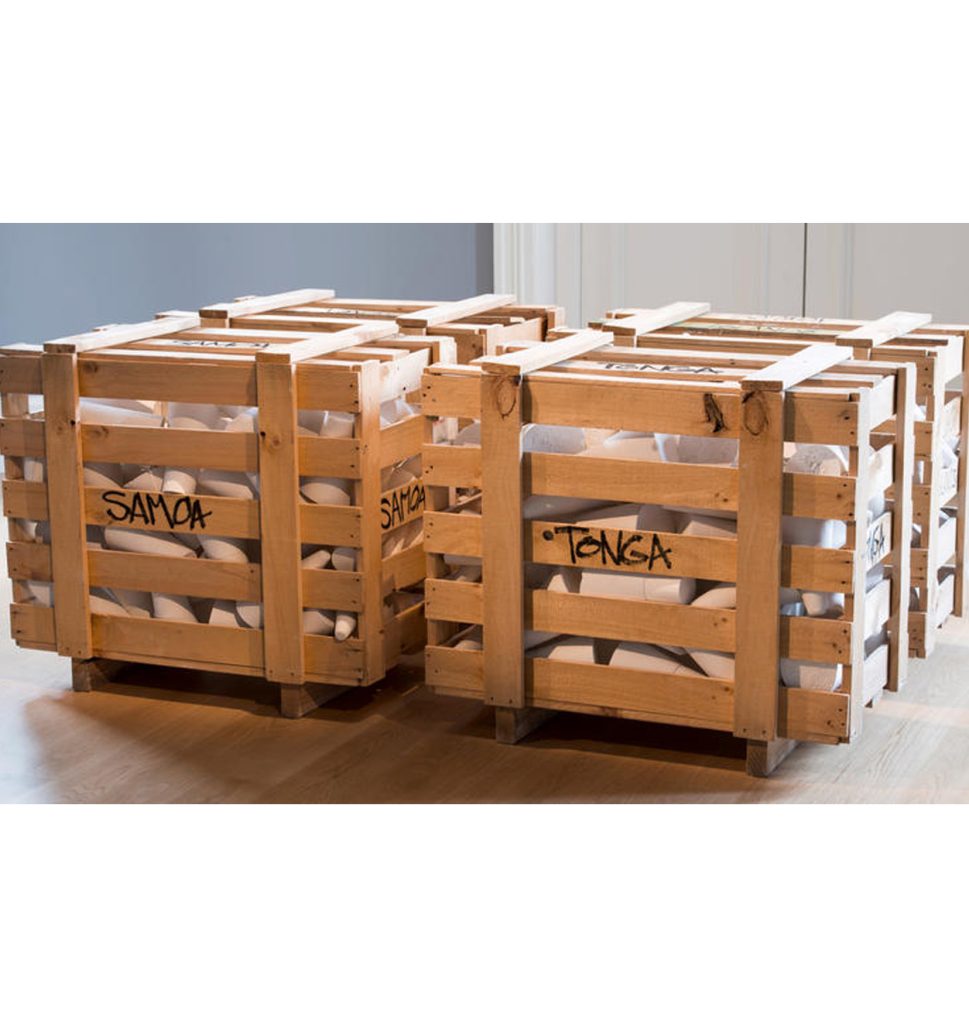
Import/Export, 2008-2016, plaster, wood
KALISOLAITE ‘UHILA (B. 1981)
Tongan
Kalisolaite ‘Uhila is a Tongan performance artist based in Tāmaki Makaurau, Auckland. His work explores issues of cultural bias, masculinity and tradition which is often informed by his Tongan heritage.
FLORENCE ULUTUNU
Sāmoan, Siumu, Sāmusu,
Florence Ulutunu is a multidisciplinary artist of Sāmoan descent based in Aotearoa. She works across a range of different media that reflects her Pasifika identity including Siapo cloth. Her passion for heritage arts allows her to navigate ‘reality through an ancestral lens’.
Dorothy Waetford (b. 1967)
Iwi: Ngātiwai, Ngāti Hine, Ngāpuhi-nui-tonu/Ngāpuhi
Auckland Art Gallery, Toi o Tāmaki
Te Atinga
Dorothy Waetford is a contemporary Māori artist who began her career as a performing artist in the contemporary Māori dance company Taiao. In the 1990s, she transitioned to working in clay, which has become her primary medium.
Waetford’s sculptural works draw on Māori oral and visual traditions and incorporate elements of te reo Māori, the Māori language. Her recent works give a physical form to the sound and cultural narratives of the language. Through her work, Waetford seeks to explore and celebrate Māori culture and traditions while also pushing the boundaries of contemporary Māori art.
VANESSA WAIRATA EDWARDS (B. 1980)
Iwi: Ngāti Tūwharetoa
Auckland Art Gallery, Toi o Tāmaki
Instagram
Vanessa Edwards is a contemporary Māori artist who primarily works in printmaking. She graduated from the Quay School of Arts at the Universal College of Learning in Whanganui in 2002 and is one of the founding members of Toi Whakaata Māori Print Collective.
Her work often incorporates weaving patterns and techniques, either through the use of woven surfaces or by incorporating woven designs into her prints. Edwards explores the role of tikanga Māori (Māori customs) and matauranga Māori (Māori knowledge) in contemporary society, creating works that reflect on Māori culture and identity.
JOHN WALSH (B. 1954)
IWi: te Aitanga a Hauiti, New Zealand Irish
Page Galleries
Gow Langsford Gallery
John Walsh is a New Zealand artist who is known for his figurative paintings that blend Māori mythology and legend with contemporary societal commentary. Working primarily with oil paint, he creates surrealistic works that are intuitive and spontaneous, often not planning a composition but allowing it to unfold in the process. This creates an ethereal mood and timelessness within his works, as legends of the past are encountered in new and unexpected ways.
Walsh’s paintings often feature strong, powerful female figures that are central to his compositions. He draws inspiration from Māori mythology and legends, and uses these stories to explore contemporary issues facing New Zealand society. His works are highly evocative, and convey a sense of mystery and wonder that draws the viewer in.
MARILYNN WEBB (1937-2021)
Iwi: Ngāpuhi, Te Roroa
Auckland Art Gallery, Toi o Tāmaki
De Novo Gallery
Marilynn Webb was a highly respected New Zealand artist who is best known for her work in printmaking. She has been committed to printmaking as her main artistic mode since the 1960s and has established herself as a leader in the medium. Throughout her long career, Webb has engaged in a social commentary about environmental concerns, feminist issues, and Māori and postcolonial history.
Webb’s pastel and print series have focused on New Zealand’s southern wilderness areas, including Lake Mahinerangi, the Ida Valley, Fiordland, and Stewart Island. She was particularly interested in remote and fragile environments and her work draws attention to the environmental and social issues surrounding them. Webb’s art makes us aware that we are always in the landscape, and she uses her work to explore concepts of land, ecology, politics, women in art, and Māori and post-colonial history.
DAME ROBIN WHITE
Iwi: Ngāti Awa
McLeavey Gallery
Auckland Art Gallery
After ten years of establishing herself as a painter and screen-print maker in New Zealand, Robin embarked on a new chapter in Kiribati. Living on the Tarawa lagoon, the unique physical and social environment of the island nation brought about changes in her artistic works. Her deep love for Pacific culture took on a new direction as she started engaging in collaborative art-making.
However, a significant setback occurred when a fire destroyed her home and studio in 1996. With limited resources and no dedicated workspace, Robin found innovative ways to merge Western art practices with Pasifika approaches to create art. She began collaborating with a diverse group of individuals, including Kiribati women, Fijians, New Zealanders, and her vibrant Tongan collaborator Ruha Fifita.
LUKE WILLIS THOMPSON (B. 1988)
Iwi: Fijian
Luke Willis Thompson is a New Zealand multidisciplinary artist of Fijian and European heritage. Willis Thompson works across filmography, performance and installation to investigate issues of colonialism, race, class and institutional violence. He was a nominee for the 2018 Turner Prize, where he created silent black and white films of performances by those who are fundamentally affected by police and state brutality.
ARETA WILKINSON (B. 1969)
Iwi: Te Whānau-ā-Apanui
Auckland Art Gallery, Toi o Tāmaki
Two Rooms
Dr. Areta Wilkinson is acontemporary artist who is known for her conceptual approach to creating art. Her work is often associated with contemporary jewellery, as she uses materials such as precious metals and stones, but she also incorporates installation and performance into her practice.
One of the key aspects of Wilkinson’s work is her exploration of Māori philosophies, specifically whakapapa, which refers to the interconnectedness of all things and the importance of genealogy in Māori culture. She incorporates these ideas into her work through her use of materials and the way she constructs her pieces.
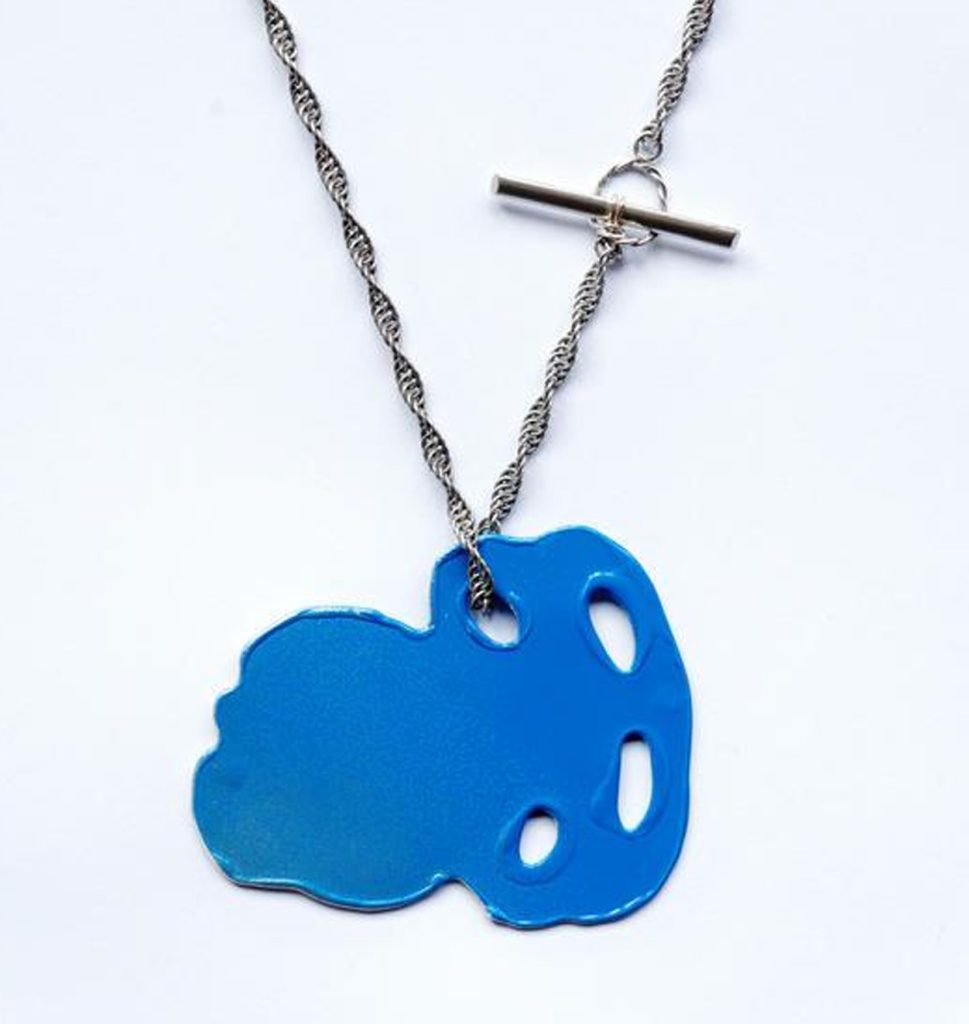
LAURA WILLIAMS (B. 1965)
New Zealander
Laura Williams, born in 1965 in Tāmaki Makaurau Auckland, has established her practice firmly over the past decade and received numerous awards and residencies for her work. With a background in Sociology and a career as a union organizer, Williams is deeply interested in the intricacies of human interactions. Her paintings reflect a sense of joyful irreverence and sharp humor. They are infused with references to religion, art history, pornography, design, and social theory. Williams often situates her figures in idyllic landscapes or emotionally charged domestic settings filled with vibrant colors and intricate patterns. These settings are often strewn with the clutter and remnants of daily life, and the figures themselves are frequently depicted in various states of undress.
SELWYN WILSON (1927-2002)
Iwi: Ngāti Manu, Ngāti Hine
Auckland Art Gallery, Toi o Tāmaki
Whangārei Art Museum
Selwyn Wilson, one of the pioneers of Māori Modernism, was born in Taumarere, in Te Tai Tokerau/Northland. He was a prominent figure in the contemporary Māori art movement in the 1950s and 1960s, along with other renowned artists such as Ralph Hotere, Dame Kāterina Mataira, Muru Walters, and Arnold Manaaki Wilson.
Wilson began his artistic training at the Elam School of Fine Arts in 1945 and became one of the school’s first Māori art students. His portrait, Study of a head, was purchased by Auckland Art Gallery Toi o Tāmaki in 1948, making it the first piece of contemporary Māori art to enter a public art collection.
He was part of the Northern Māori Project in the 1950s, which aimed to promote Māori art and culture. Wilson received the Sir Āpirana Ngata Memorial Scholarship in 1957 to study at the Central School of Arts and Crafts in London, where he focused on ceramics. He later became the head of the art department of Bay of Islands College in 1970, after working at Northland College in Kaikohe.
TOSS WOOLLASTON (1910-1998)
New Zealander
Mountford Tosswill Woollaston, also known as Toss Woollaston, is a prominent figure in the history of 20th-century art in New Zealand. Often referred to as the “Cezanne of the Pacific,” he made significant contributions to the artistic landscape of the country. Prior to pursuing painting, Woollaston had a strong inclination towards poetry and initially aspired to be a writer. In 1928, Woollaston began working as a horticultural laborer in Nelson. He later moved to Christchurch, where he briefly studied at Canterbury College School of Art. He continued his artistic education at the Dunedin School of Art in Otago before ultimately settling in Mapua. Throughout his career, Woollaston actively engaged in critical and intellectual debates, notably participating in discussions regarding the artist’s role in the context of fascism, as seen in his exchange with writer Winston Rhodes in the journal Tomorrow, established in 1934 to encourage cultural debate and dialogue.
PAULINE YEARBURY (1927-1977)
Iwi: Ngāpuhi
Auckland Art Gallery, Toi o Tāmaki
Toi Iho
Pauline Yearbury (née Blomfield) was an accomplished Māori artist born in Mātauri Bay, Te Tai Tokerau/Northland. She was one of the first Māori women, along with Dame Kāterina Mataira, to attend the Elam School of Fine Arts in Auckland, beginning her training in 1943 and later becoming a tutor.
After completing six years at Elam, Yearbury returned to Russell in 1952 where she and her husband James, also an Elam graduate, worked together as house painters. They were later commissioned to create several large murals that told stories from local history.
Yearbury’s artistic practice was rooted in ancestral knowledge, and she was committed to retelling Māori mythology through her work. She often used incised wood panels to create figurative scenes that were depicted in an abstract and stylized manner.
Yearbury’s dedication to her craft and her commitment to preserving Māori culture and mythology have made her an important figure in New Zealand’s art history. Her work serves as a reminder of the richness and complexity of Māori culture, and her legacy continues to inspire and influence generations of artists.
